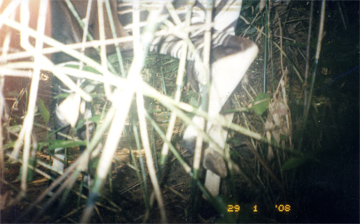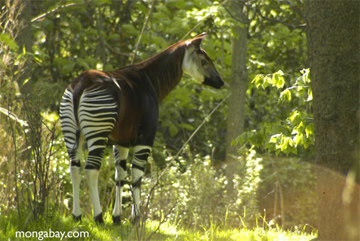Rare okapi photographed for the first time in Congo park
Rare okapi photographed for the first time in Congo park
mongabay.com
September 10, 2008
|
|
A camera trap has captured the first-ever photo of an okapi in the Democratic Republic of Congo’s Virunga National Park. The picture shows that the elusive forest giraffe has managed to survive more than a decade of war in and around the park.
“This is the first time this species has been captured on film in this park. Known to occur in the park from the early 1900s it had not been seen here for over 50 years. Two years ago sightings of dung and other tracks were made in the park by a team of pygmy trackers who knew Okapi sign. It is very encouraging to see that this animal has survived,” said Deo Kujirakwinja, who organized the recent camera trap survey for the Wildlife Conservation Society (WCS). “Many animals have suffered in this park as a result of the ten years of insecurity in the region, so it’s encouraging to see that the okapi has survived.”
  Camera trap image courtesy of WCS; lower photo of a captive okapi by Rhett A. Butler |
The okapi, which stands up to 6 feet tall at the should and can reach 8 feet in length, is endemic to the Congo rainforest. While it is not endangered, the species faces increased risk from poaching and habitat destruction.
The photograph was taken during a WCS survey of the remote northern forests of the Virunga Park, an area that was a hideout for the Allied Democratic Front (ADF), a rebel group that has battled the government of Uganda for more than two decades. The U.S. Fish and Wildlife-sponsored surveys aim to "assess the impact of the war on the fauna and flora of this region," according to WCS. "The preliminary results indicate that many antelope species are at low density but that some species such as chimpanzees have survived fairly well."
“The recent evidence that okapis still exist in the Virunga National Park is a good indication that large wildlife can rebound in areas impacted by unrest and poaching,” said Dr. Andrew Plumptre, director of WCS’s Albertine Rift Program.